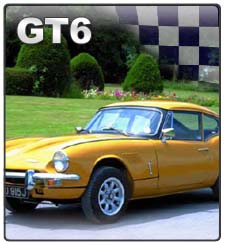Triumph GT6 Introduction
 Born in LeMans
Born in LeMans
Only a year after the Spitfire went into production in 1962, Triumph built a prototype 'Spitfire GT', with a smart fastback coupe body style.
Within months this one-off car was further modified, with a sixcylinder engine - and the GT6 project got under way.
As a prelude, 'works' Spitfires with GT6-style bodies raced at Le Mans in 1964 and 1965, before the original GT6 road car was introduced in October 1966. These first cars used modified versions of the Spitfire chassis and suspensions, but shared almost all of their running gear - 2-litre six cylinder engine, all-synchromesh gearbox with optional overdrive, and a more robust rear axle - with the Vitesse 2-litre model.
Because of the new car's character, which combined the sleek styling, a silky-smooth six-cylinder engine, high gearing, and a characteristic exhaust note, with a well-equipped two-seater cabin and a lift-up rear hatch, the new GT6 was often dubbed a 'mini-E-Type'. Triumph was happy to develop this image for the new car, wanting it to be seen as an altogether more up-market model than the Spitfire. The original cars, built until the autumn of 1968, had 95bhp 2- litre engines, and could reach about 105mph. All had the same type of polished walnut interior, and a large carpeted space behind the seats. Although both were optional extras, many cars were sold with overdrive, and with centre-lock wire spoke wheels.
Although the GT6 was an immediate sales success, there was criticism of the car's swing-axle rear suspension, and of the poor ventilation of the small cabin. Major improvements to the roadholding could only be made by a complete re-design, so for the GT6 Mk2 Triumph abandoned the swing-axle system, substituting a new layout which kept the transverse leaf spring, but also used a reversed lower wishbone: wheel camber changes were much reduced.
The GT6 Mk2 was a much-improved car. Not only did it have much better roadholding than before, but there was a new type of cylinder head and more peak power (104bhp instead of 95bhp), a new facia style, cabin air outlets and a heated rear window glass both helping to improve the ventilation.
Styling retouches for the Mk2 included a raised front bumper and Rostyle wheel covers, while from late 1969 more improvements included reclining seats and a new-style steering wheel.
From late 1970 the GT6 Mk3 took over, this sharing many styling changes with the latest Spitfire, the Mk IV. Although this was basically the same shape as before, almost every external panel was changed and was more smoothly detailed than before. Perhaps this was aerodynamically smoother than before, for the car's top speed rose to 112mph.
Raised panel joints on front and rear wings had been eliminated, the side window profile was altered, and there was now to be a sharply cut-off rear panel. Yet another wheel style was chosen, and the front bumper was closely integrated into the new-shape front pressings. The Mk3 was very popular in the UK, where sales rose sharply, but less so in the USA, where new exhaust emission and other safety regulations degraded the performance and hit all British sports car sales. For 1973 there was one final change to the GT6's chassis specification, where the latest Spitfire type of 'swing spring' type of swing-axle rear suspension took over from the unique 'lower wishbone' type, but relatively few of these cars were ever made. The last GT6 of all was built in November 1973.